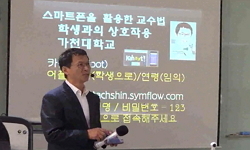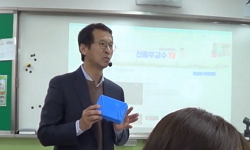교육 패러다임이 점차 학습자 중심으로 변화함에 따라 학습자의자기 주도적 학습 능력을 지원할 수 있는 학습환경이 강조되고 있다. 이에 따라, 국내 원격대학 사이버 강의실의 웹 메뉴 ...
http://chineseinput.net/에서 pinyin(병음)방식으로 중국어를 변환할 수 있습니다.
변환된 중국어를 복사하여 사용하시면 됩니다.
- 中文 을 입력하시려면 zhongwen을 입력하시고 space를누르시면됩니다.
- 北京 을 입력하시려면 beijing을 입력하시고 space를 누르시면 됩니다.
이러닝 환경에서 학습관리시스템(LMS) 강의실 환경이 학습동기 및 상호작용에 미치는 영향 : 원격대학 사이버 강의실의 웹 메뉴 기능을 중심으로 = The Effects of Classroom Environment with a Learning Management System on Motivation to Learn and Interaction in e-Learning Environment - Focused on Web-Menu Functions in Online Classrooms of Cyber Universities
한글로보기https://www.riss.kr/link?id=T11217801
- 저자
-
발행사항
부산 : 부산대학교 대학원, 2008
-
학위논문사항
학위논문(석사) -- 부산대학교 대학원 , 인지과학협동과정 이러닝 , 2008. 2
-
발행연도
2008
-
작성언어
한국어
- 주제어
-
발행국(도시)
부산
-
형태사항
v, 89 p. ; 26 cm
-
일반주기명
지도교수: 손건태
- DOI식별코드
- 소장기관
-
0
상세조회 -
0
다운로드
부가정보
국문 초록 (Abstract)
[연구문제 1] 학생 및 교수집단 간에 학습관리시스템 사이버 강의실 웹 메뉴 기능의 학습동기 유발에 대한 인식의 차이는 어떠하며, 사이버 강의실 웹 메뉴가 학습동기에 끼치는 영향은 무엇인가?
사이버 강의실 웹 메뉴가 학습동기에 미치는 영향으로는 첫째, 코스에 대한 흥미를 끌 수 있는 웹메뉴로 강의리스트, 자료실, 수강생리스트 순으로 나타났다. 특히, 수강생리스트가 코스에 대한 흥미를 유발시키는 것은 일반적으로 독립된 공간에서 홀로 학습하는 학습환경에 따른 이러닝 학습자의 심리적 특성이 반영된 것으로, 학습자간의 상황인식이 매우 중요함을 의미한다. 둘째, 자극성 영역에서는 질문답변, 수강생리스트, 조편성으로 나타났는데, 이들 웹 메뉴 이름 및 구조가 가장 우선 개선할 필요성이 있는 것으로 볼 수 있다. 셋째, 의미성 영역으로 강의리스트가 가장 유의미한 것으로 나타났는데, 학습자는 주로 학습콘텐츠를 통해 이러닝 학습의 의미성을 찾고자 하며, 사이버대학의 경우 학습콘텐츠를 통해서만 출석인정을 하는 경우가 보편적이기 때문에 이와도 관련이 있는 것으로 볼 수 있다.
[연구문제 2] 학생 및 교수집단 간에 학습관리시스템 사이버 강의실 웹 메뉴 기능의 상호작용 효과에 대한 인식의 차이는 어떠하며, 사이버 강의실 웹 메뉴가 상호작용 효과에 끼치는 영향은 무엇인가?
상호작용 기능에 있어서 디지털리터러시 능력 차이에 따른 사이버 강의실 웹 메뉴의 상호작용 기능 인식하는 차이가 존재하는 것으로 나타났다. 특히, 이러닝 교수자-학습자는 주로 빠른 피드백과 개별적 피드백을 요하는 기능인 전화, 채팅, 문자메시지 등에서 상호작용 효과를 인식하고 있는 것으로 나타나고 있는 것으로 나타나고 있다.
[연구문제 3] 교육형태(사이버 전용과 혼합형)에 따른 사이버 강의실 웹 메뉴의 학습동기 및 상호작용 효과는 어떠하며, 집단 간 사이버 강의실 웹 메뉴의 학습참여에 대한 영향은 어떠한가?
교육 형태에 따른 사이버전용 학습자와 혼합형 학습자의 학습동기에 대한 인식차이는 통계적으로 유의미하지 않았으나, 면대면 환경을 포함하고 있는 혼합형 학습자의 코스흥미도, 자극성, 의미성과 관련한 학습동기 모두 사이버전용 학습자에 비해 높은 평균을 나타내고 있어, 학습동기 수준은 혼합형 학습자가 사이버전용 학습자 보다 높게 비교적 높게 인식된다고 할 수 있다. 또한, 이들의 상호작용에 대한 인식차이는 채팅에서만 통계적으로 유의미하게 나타나고 있는데, 이는 교수자ㆍ학습자, 학습자간 비언어적 의사소통뿐만 아니라 언어적 의사소통을 포함하고 있기 때문인 것으로 보인다.
교육 패러다임이 점차 학습자 중심으로 변화함에 따라 학습자의자기 주도적 학습 능력을 지원할 수 있는 학습환경이 강조되고 있다. 이에 따라, 국내 원격대학 사이버 강의실의 웹 메뉴 기능이 교수자-학습자에게 어떻게 인식되고 있는지 학습동기 및 상호작용적 측면에서 살펴보고자 하였다. 연구결과를 요약하면 다음과 같다.
[연구문제 1] 학생 및 교수집단 간에 학습관리시스템 사이버 강의실 웹 메뉴 기능의 학습동기 유발에 대한 인식의 차이는 어떠하며, 사이버 강의실 웹 메뉴가 학습동기에 끼치는 영향은 무엇인가?
사이버 강의실 웹 메뉴가 학습동기에 미치는 영향으로는 첫째, 코스에 대한 흥미를 끌 수 있는 웹메뉴로 강의리스트, 자료실, 수강생리스트 순으로 나타났다. 특히, 수강생리스트가 코스에 대한 흥미를 유발시키는 것은 일반적으로 독립된 공간에서 홀로 학습하는 학습환경에 따른 이러닝 학습자의 심리적 특성이 반영된 것으로, 학습자간의 상황인식이 매우 중요함을 의미한다. 둘째, 자극성 영역에서는 질문답변, 수강생리스트, 조편성으로 나타났는데, 이들 웹 메뉴 이름 및 구조가 가장 우선 개선할 필요성이 있는 것으로 볼 수 있다. 셋째, 의미성 영역으로 강의리스트가 가장 유의미한 것으로 나타났는데, 학습자는 주로 학습콘텐츠를 통해 이러닝 학습의 의미성을 찾고자 하며, 사이버대학의 경우 학습콘텐츠를 통해서만 출석인정을 하는 경우가 보편적이기 때문에 이와도 관련이 있는 것으로 볼 수 있다.
[연구문제 2] 학생 및 교수집단 간에 학습관리시스템 사이버 강의실 웹 메뉴 기능의 상호작용 효과에 대한 인식의 차이는 어떠하며, 사이버 강의실 웹 메뉴가 상호작용 효과에 끼치는 영향은 무엇인가?
상호작용 기능에 있어서 디지털리터러시 능력 차이에 따른 사이버 강의실 웹 메뉴의 상호작용 기능 인식하는 차이가 존재하는 것으로 나타났다. 특히, 이러닝 교수자-학습자는 주로 빠른 피드백과 개별적 피드백을 요하는 기능인 전화, 채팅, 문자메시지 등에서 상호작용 효과를 인식하고 있는 것으로 나타나고 있는 것으로 나타나고 있다.
[연구문제 3] 교육형태(사이버 전용과 혼합형)에 따른 사이버 강의실 웹 메뉴의 학습동기 및 상호작용 효과는 어떠하며, 집단 간 사이버 강의실 웹 메뉴의 학습참여에 대한 영향은 어떠한가?
교육 형태에 따른 사이버전용 학습자와 혼합형 학습자의 학습동기에 대한 인식차이는 통계적으로 유의미하지 않았으나, 면대면 환경을 포함하고 있는 혼합형 학습자의 코스흥미도, 자극성, 의미성과 관련한 학습동기 모두 사이버전용 학습자에 비해 높은 평균을 나타내고 있어, 학습동기 수준은 혼합형 학습자가 사이버전용 학습자 보다 높게 비교적 높게 인식된다고 할 수 있다. 또한, 이들의 상호작용에 대한 인식차이는 채팅에서만 통계적으로 유의미하게 나타나고 있는데, 이는 교수자ㆍ학습자, 학습자간 비언어적 의사소통뿐만 아니라 언어적 의사소통을 포함하고 있기 때문인 것으로 보인다.
다국어 초록 (Multilingual Abstract)
[Inquiry 1] What differences are there between student and teacher groups in awareness of motivation to learn by web-menu functions in online classrooms with the Learning Management System and how do web menus in online classrooms affect motivation to learn?
Effects of web menus in online classrooms on motivation to learn included, first of all, a lecture list, followed by resource rooms and a student list, as web menus which could attract interest in the course. In particular, the fact that a student list may induce interest in the course reflects e-learners' psychological properties by learning environment where they study alone in isolation and places great importance on awareness of situations among learners. Second, in the stimulation area, there were question and answer, a student list, and team organization; names and structures of these web menus showed the most urgent need for improvement. Third, in the meaningfulness area, a lecture list was the most meaningful, which was probably because learners tried to find out meaningfulness of e-learning primarily through learning contents and cyber universities tended to recognize attendance only through learning contents.
[Inquiry 2] What differences are there between student and teacher groups in awareness of effects of web-menu functions in online classrooms with a learning management system on interaction and how do web menus in online classrooms affect effectiveness of interaction?
There were differences in awareness of interactive functions of web menus in online classrooms by differences in digital literacy. In particular, e-learning instructors and learners were found to be aware of effectiveness of interaction in telephoning, chatting, and sending a written message, all of which are functions mainly requiring quick and individual feedback.
[Inquiry 3] How are effects of web menus in online classrooms on motivation to learn and interaction by educational types (for on-web-based or blended) and how do web menus in online classrooms affect learning participation in two groups?
While differences in awareness of motivation to learn between only-web-based and blended learners by educational types were not statistically significant, motivation to learn related to all of interest in the course, stimulation, and meaningfulness for blended learners including face-to-face environment showed a higher mean than that of only-web-based learners, which demonstrates that blended learners have relatively better awareness of the level of motivation to learn than only-web-based ones. Differences in their awareness of interaction were statistically significant only in terms of chatting, which was probably because instructor-learner and learner-learner verbal communication was included in addition to nonverbal one.
As an educational paradigm gradually changes into learner-centered one, emphasis is placed on learning environment to support learners' self-directed learning abilities. In particular, it is very important to note that classroom environment with the L...
As an educational paradigm gradually changes into learner-centered one, emphasis is placed on learning environment to support learners' self-directed learning abilities. In particular, it is very important to note that classroom environment with the Learning Management System which is a basic tool to support teaching-learning between a learner and an instructor in learner-centered online learning offers functions to facilitate motivation to learn and interaction. Therefore, this study intended to see how web-menu functions in online classrooms of local cyber universities were perceived by instructors and learners in terms of motivation to learn and interaction. The results of this research can be summarized as follows.
[Inquiry 1] What differences are there between student and teacher groups in awareness of motivation to learn by web-menu functions in online classrooms with the Learning Management System and how do web menus in online classrooms affect motivation to learn?
Effects of web menus in online classrooms on motivation to learn included, first of all, a lecture list, followed by resource rooms and a student list, as web menus which could attract interest in the course. In particular, the fact that a student list may induce interest in the course reflects e-learners' psychological properties by learning environment where they study alone in isolation and places great importance on awareness of situations among learners. Second, in the stimulation area, there were question and answer, a student list, and team organization; names and structures of these web menus showed the most urgent need for improvement. Third, in the meaningfulness area, a lecture list was the most meaningful, which was probably because learners tried to find out meaningfulness of e-learning primarily through learning contents and cyber universities tended to recognize attendance only through learning contents.
[Inquiry 2] What differences are there between student and teacher groups in awareness of effects of web-menu functions in online classrooms with a learning management system on interaction and how do web menus in online classrooms affect effectiveness of interaction?
There were differences in awareness of interactive functions of web menus in online classrooms by differences in digital literacy. In particular, e-learning instructors and learners were found to be aware of effectiveness of interaction in telephoning, chatting, and sending a written message, all of which are functions mainly requiring quick and individual feedback.
[Inquiry 3] How are effects of web menus in online classrooms on motivation to learn and interaction by educational types (for on-web-based or blended) and how do web menus in online classrooms affect learning participation in two groups?
While differences in awareness of motivation to learn between only-web-based and blended learners by educational types were not statistically significant, motivation to learn related to all of interest in the course, stimulation, and meaningfulness for blended learners including face-to-face environment showed a higher mean than that of only-web-based learners, which demonstrates that blended learners have relatively better awareness of the level of motivation to learn than only-web-based ones. Differences in their awareness of interaction were statistically significant only in terms of chatting, which was probably because instructor-learner and learner-learner verbal communication was included in addition to nonverbal one.
목차 (Table of Contents)
- 제1장 서론 = 1
- 제1절 연구의 필요성 및 의의 = 1
- 제2절 연구 문제 = 3
- 제3절 논문의 구성 = 5
- 제2장 이론적 배경 = 6
- 제1장 서론 = 1
- 제1절 연구의 필요성 및 의의 = 1
- 제2절 연구 문제 = 3
- 제3절 논문의 구성 = 5
- 제2장 이론적 배경 = 6
- 제1절 사이버 강의실에 대한 이론적 접근 = 6
- 1. 사이버 강의실의 개념 = 6
- 2. 웹기반 협력학습으로서의 사이버 강의실 = 10
- 제2절 이러닝(e-Learning)에서의 학습동기 및 상호작용 = 14
- 1. 학습동기 = 14
- 2. 상호작용 = 19
- 제3장 연구방법 = 24
- 제1절 연구설계 = 24
- 1. 표본의 선정 = 24
- 2. 표집절차 = 24
- 3. 설문지의 구성 = 25
- 4. 자료수집 = 27
- 제2절 조사방법 = 28
- 1. 독립 변수 = 28
- 2. 종속 변수 = 32
- 제3절 자료분석 = 32
- 제4장 연구결과 = 33
- 제1절 인구통계학적 속성 및 신뢰도분석 = 33
- 제2절 분석 결과 = 35
- 1. 일반적 분석 = 35
- 2. 결과 분석 = 38
- 제5장 결론 = 59
- 제1절 연구결과의 요약 = 59
- 제2절 시사점 = 63
- 제3절 연구의 한계 및 제언 = 65
- <참고문헌> = 67
- <설문지> = 71
- [부록] = 82
- Abstract = 87












